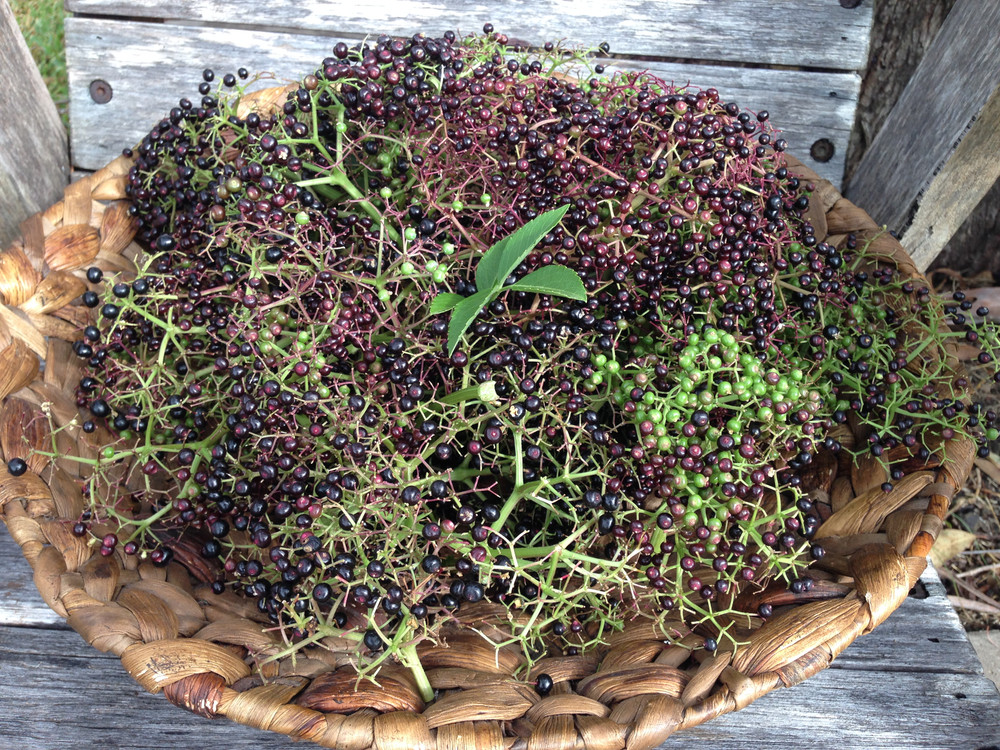
Black Elderberry bushes have been found in many parts of the world and grow very well as a native bush right here in Australia. The Australian Elder Berry bush can grow as high as 4 – 6 metres and begin to bloom in late spring with small white flowers followed by small green berries which ripen to a rich black dark purple colour.
Both the berries and the flowers are edible if harvested and prepared correctly. Full of good immune building properties, they are highly recommended to be used in your GAPS daily juicing (about 1 – 2 tablespoons is ideal). You can harvest them during summer and cook and freeze enough for the winter. The flowers also hold great immune properties and can be used in salads and tea.
BLACK ELDERBERRY FACTS
- Recent studies in 2009 have shown how Black elderberry extract has shown to be at least 68.37% effective against the H1N1 strain otherwise known as Swine Flu Pandemic strain.
- Studies have shown how Black elderberry extract has been found to be effective against the H5N1 strain of Avian Flu (Zakay-Rones et al 1995).
- Black Elderberries are rich in anthocyanins which are a type of flavonoid – anthocyanins are antioxidants that may protect cells from free radicals and support your body’s immune system.
THE DEBATE ABOUT WHETHER THE ELDERBERRY IS POISONOUS
There have been mixed conclusions as to whether the Black Elderberries are in fact poisonous to eat! Many people have heard that elderberry bushes are poisonous and yet have also heard that the elderberry contains many beneficial immune properties too. The truth is yet to be fully revealed and is somewhat blurred, however my findings came up consistent with parts of the elderberry bush being poisonous with caution to consume it, in contrast to other parts of the tree (such as the ripe berries and flowers), when harvested and prepared correctly, are completely safe to eat. I believe that the black elderberry is an incredibly useful berry for it’s immune properties and it’s plant deserves a spot in your home garden but it is important to read on to learn a little more about it's probable safe consumption.
In terms of it’s safety, my findings have shown the following: the seeds, stems, leaves and roots of the Black Elder are all poisonous to humans. Any Green berries must be avoided also. These all contain a cyanide-inducing glycoside. Eating a sufficient quantity of these cyanide-inducing glycosides can cause a toxic buildup of cyanide in the body and make you quite ill. The fruit of the elderberry is a tiny berry, about 1/8 to ¼ inch in diameter, and about 50% of the berry is seed. Apparently, cooking the berries destroys the glycosides present in the seeds, making the berries with their seeds safe to eat. As such, the fruit of the Black Elderberry should always be cooked before consumption. Interestingly, my research reveals that exposing elderberry to heat actually concentrates the polyphenols and anthocyanins. The flowers however are safe to eat and contain good immune properties also.
There has been quite a bit of debate on the elderberry being truly poisonous at all and a lot of this controversy surrounds the big pharma industry and their profits but I have found nothing to prove this and believe the best approach is to steam the berries upon harvest first, let them cool and then freeze them for later juicing. Alternatively you can cook the berries in cakes etc to remove the potential glycosides present in the elderberry seeds.
Black Elderberry has a very long history of culinary and medicinal uses and once you know which parts of the plant to use, and how to prepare the berries for consumption, the rest is a piece of cake.
GROW AND HARVEST YOUR OWN
Black Elderberry is a useful plant in any home garden and doing your research to determine which variety will grow best in your environment is worth the effort.
You can ask your local organic nursery if they Stock them and grow them in your backyard or alternatively, you can become very familiar with what they look like and go on an Elderberry hunt and pick a big batch with the family.You will be surprised how common they are in some backyards in Australia and many creek beds are lined with them.
Black Elderberry is a great choice for low-lying areas, in the back of a garden, or for use as a hedge. Prepare the soil well before planting as elderberry enjoys well composted material and good drainage. Plan on watering your new elderberry plant once a week or so for the first summer of its life. Pinch off flower heads during its first year of life, too, to encourage root growth. After that, stand back! And remember that if your elderberry bush becomes too big for your space, you can easily control its size through pruning and then keeping the area around it well mowed.
Subscribe to our Cooking Program to see our Banana and Black Elderberry Muffin Crumble Tops. So delicious! YUMMMM
